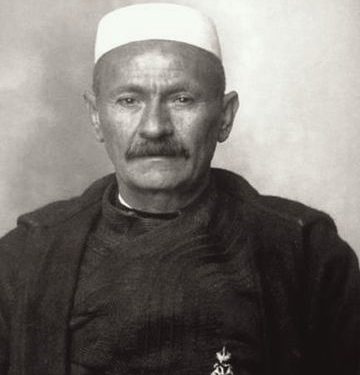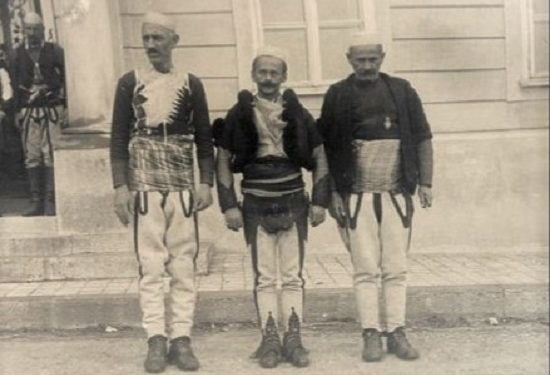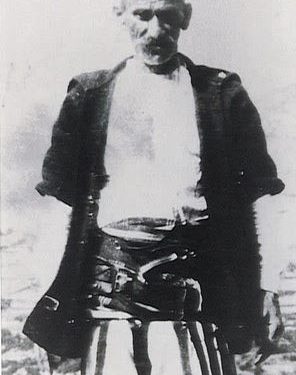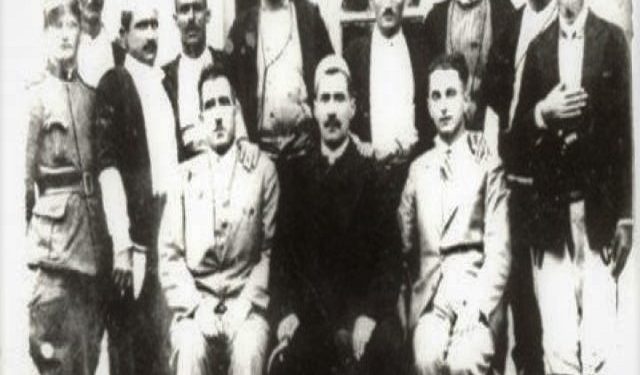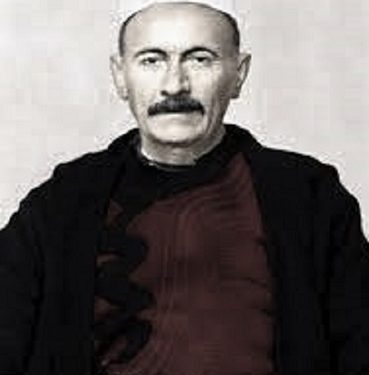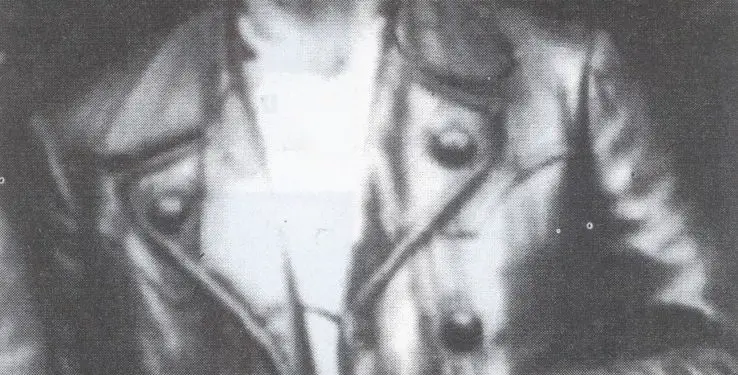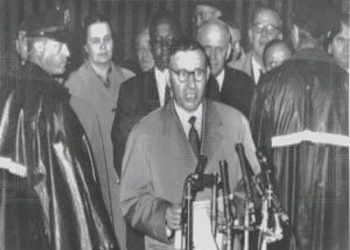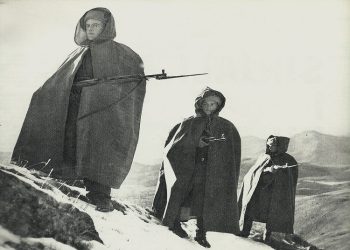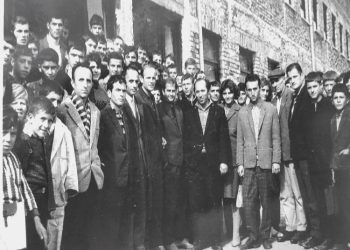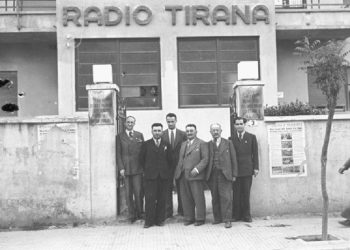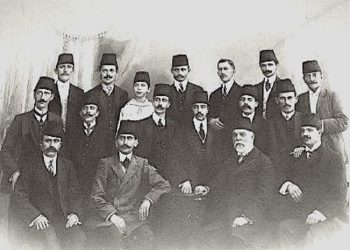Dashnor Kaloçi
Memorie.al publishes the unknown story of the large Ndreu family from the village of Sllova e Dibra, where their leader, Cen Elezi, stood out as a popular leader of Dibra volunteers in the wars to protect the north-eastern borders of Albania from attacks by formations Serbo-Montenegrin and in 1924, as a close friend of Bajram Curri, he sided with the fan forces in the ‘June Uprising’ and was killed in late December of that year when Zogu returned to Albania. Rare testimony of his nephew, Hiqmet Ndreu, son of Cen Elez, one of the most famous figures of all Northern Albania, who took his father’s place at the head of the Ndreu tribe and during the period of occupation of the country in the years In 1939-1944, their house in the village of Slovo, Dibra, became one of the main bases of the Anti-Fascist War, housing both nationalist and partisan forces, as two of the sons of this family, Major General Dali Ndreu and Lieutenant Colonel Esat Ndreu, were in leadership positions as division and brigade commanders in the National Liberation Army led by Enver Hoxha and Spiro Moisiu, which led to the bombing of that large house by Italian aircraft in 1943. Ndreu’s large family’s contradictions with Enver’s communist regime Hoxha in the first years after the war, where Cen Elezi, although deputy chairman of the Democratic Front of Albania (Enver’s deputy), did not agree with his pro-Yugoslav policy and left from there. went to the mountains with his sons and grandsons, which led to the family being persecuted by the ruling communist regime, where as a result 6 men from this family were shot, 20 others were imprisoned and spent tens of years in prison, 12 people were fled Albania and 55 families were interned and suffered in Vlora and Myzeqe internment camps until 1991
“After the end of the war until March 1946, our Ndreu family in Sllova of Dibra was not affected at all by the communist regime of Enver Hoxha. The main reason and reason that our family was not disturbed at first was the little respect that was still preserved for Major General Dali Ndreu and Lieutenant Colonel Esat Ndreu, who had led some of the major partisan formations during the National Liberation War, such as Division I- Attacker commanded by Daliu, who also fought for the liberation of Tirana. The savage and unprecedented persecution and genocide against our family began after March 1946, when our grandfather Cen Elezi, the son of the “People’s Hero”, Elez Isuf Ndreu, was declared “enemy of the people”. At that time, to escape the pursuit of the partisan units that at that time were known as the People’s Defense Division, which burned down the large three-storey towers in the village of Slovo, grandfather Ceni, with some of his brothers and sons, to The escapee left the tower shortly before their arrival and fled to the mountains. At that time, some of the men of our family were killed in the mountains in a struggle with the communist forces, others fled outside Albania and many others were arrested and ended up in the prisons and internments of the communist regime of Enver Hoxha “. This is what Hiqmet Ndreu, one of the sons of the large family of Elez Isuf Ndreu, who fled Albania in the early 1950s and lives in Australia, told among others in his testimonies, who told us the whole tragic story. of his family under the communist regime of Enver Hoxha.
Unknown story of the Ndreu family from Slovo of Dibra
The early origin of the Ndreu family from Sllova of Dibra, is thought to be from the village of Sorica of Dardha of Dibra. Regarding the origin of this tribe that has made a great name in the history of Albania, there are several different versions, which are often contradictory to each other. But those that are closest to the truth are two of them: The one that Ndretë of Dibra is thought to have come from Shoshaj of Dukagjini and the other that they have moved from the province of Nikaj Mërtur in the district of Tropoja. These two versions are also supported by some of the oldest men of the Ndreu tribe, where two of them: Islam and Remzi Ndreu, have collected their memories which have been published in Tirana in the books “There is no peace in Lisvadhe” and ” Tribe of Ndreve”. Also, regarding the history of the Ndreu tribe, the well-known historian from Dibra, Moisi Murra, has made a long study, which regarding their exact origin, stands for both versions, namely: the one they came from Shoshaj of Dukagjini. , as well as the other one from Nikaj Mërtur of Tropoja, where according to him, toponyms related to the name of this tribe are preserved today. The well-known scholar and historian Dibra, Moisi Murra, in his book, “Cen Elezi”, wrote, among other things: “The displacement of the Ndreu tribe by Nikaj Mërturi came after the members of that tribe were killed in an unequal attempt to the military forces of the Ottoman Empire and they lay able to escape alive, fled from there, and settled further into the depths of the country. This assertion is also brought from the data of the Sandzak register of 1571, where the village of Dardhë of Dibra, has 60 inhabitants, of which 53 Christian houses and 23 Muslim. (Selami Pulaha, “Albanological Research”, series of historical sciences, Prishtina 1972, p. 285, work: “Northeast provinces of the Sandzak of Dukagjini). Among the Islamized, there is also Ali Andrea, married who also enjoyed a manor. Acknowledging the fall of the letter “a” in the name Andrea, which often happens in the names of Christians in the northeastern regions of Albania, the surname Andrea, is naturally transformed into Ndrea or Ndreu. If it is assumed that the descendants of Ali Ndreu, of 1571, inherited the name of their first, until Ali Ndreu of 1817 (brother of Elez Isufi’s grandfather), we think that Ndreu is a resident of the village of Dardhë, since the first half of the 16th century, which also coincides with the Islamization of the very-eastern provinces of the Sandzak of Dukagjini. In fact, Ndretë had a good demographic development, although they fell into bloodshed and made forced movements, but always within the micro-province of Dardha. Like all highlanders on these sides, they agreed to be governed by the mountain law of traditional autonomous government itself. Honestly, they believed and were good Christians, but under the pressure of the Ottoman Turks, they were Islamized there from the years 1530-1550. The economy of the Ndreu tribe relied mainly on livestock breeding and those few plots of fragmented land, with almost no yield. For better living conditions, some of them around the years 1830-1840, left Dardha, crossed the Drini and settled in the temperate province of Ujë e Mujës (today the micro-province of Sllova). They settled in Lisivadhe, Palaman, Shafeli and Ratke. Isuf, Llan and Kazi Ndreu settled in Lisivadhe ”. According to the testimony of Hiqmet Ndreu, from the beginning of the second half of the XVIII century, or more precisely after 1850, Ndretë of Sllova e Dibra, became one of the most famous houses of that province. At that time, the first of the Nreu tribe was Xhelil Isuf Ndreu, and after his death, the “forerunner” of his tribe was inherited by his brother, Elez Isuf Ndreu. In a place called Lisivadhe where the first Ndreu tribe had settled after moving from the province of Nikaj Mërtur, at first a hut was built by Isuf Ndreu (Elez Isufi’s father), which marks the final settlement of the Ndreu in that province, from whence they would no longer move. Then, around 1884, when that family became very economically strong, Isuf Ndreu’s sons built a large, three-storey tower) which was called the “Long Tower”. The tower, which was in the shape of a fortress with walls up to a meter wide, with turrets on each floor, was built of carved stones whose location was not known and how they were transported there. The construction of that tower around 1840, is thought to have been erected, because the Ndreu tribe at that time, had fallen in blood with some other tribes of the Luma province. At that time, the men who were at the head of the Ndreu tribe, were active in the movements that were made at that time in favor of the Albanian national cause, but in any case there is no concrete document or data to prove this hypothesis. At that time, some of the tribes of Sllova became very angry with the Daci tribe of Kalis of Kukës and to protect themselves from them, they sought the help of the Ndreu tribe. To justify this and make it a fact, in 1881, Dush Zhguri sold some lands in Slovenia to Elez Isufi. However, the purchase of this land, Elez Isufi had done without the knowledge and consent of his brother, Xhelili, who at that time had fled and was staying in the mountains on the run, to escape from performing military service in the ranks of the Turkish army . After Xhelili’s death, Elez Isufi turned his eyes to Slova and built another three-storey tower there, but just then, the contradictions between the Daci and Ndreu tribes began, which lasted for years. But even after that, the two towers, in Lisivadhe and Slovo, were inhabited for years by the large patriarchal families of Isuf Ndreu’s descendants. Two years after the construction of the tower in Slovenia, Xhelil Ndreu died and his place at the head of the tribe was inherited by his two sons: Sufa and Dika. Of the two boys, the greatest name at that time was made by Sufa, who was known throughout the province as a brave and trustworthy man. Suf Xhelili, as a sign of respect, called his uncle Lala Lez (father Elez). After Xhelili’s death, the owner of the two towers became Elez Isuf Ndreu who further restored the economy of the Ndreu tribe which was engaged in livestock and viticulture. The large Ndreu family continued to live in a patriarchal and undivided manner in the two towers in Slovenia and Lisivadha, until 1918. In that year, Elezi stayed in Slovenia permanently, Hazizi in Palaman, while Sufa with Dika in Lisivadhë. Even after this separation, the descendants of Isuf Ndreu continued to coexist as before and to have a harmony and unity between them. A major factor enjoyed by the large Ndreu family among themselves was the authority of their leader, Elez Isufi, to whom no one objected. From 1912 to 1924, Elez Isufi, together with Suf Xhelili (uncle’s son) participated in all major political events in Albania. The deeds and bravery of Elezi Isufi and Suf Xhelili, have been immortalized in the popular folklore of that region. In those years their tower became one of the main centers of the patriotic movement of northeastern Albania and there gathered well-known and well-known men from all regions of the country, such as Isa Buletini, Hasan Prishtina, Bajram Curri, Islam Spahiu i Lumës, Rexhep Bajraktari i Hasit, Zija Dibra, Ramiz Daci etc. After the assassination of Elez Isufi in 1924 in the fight against the forces that supported Zog’s return to Albania, his place was taken by his son, Hysen Elez Ndreu, or as he is known, Cen Elezi, who was born in 1884. Since At a very young age, Cen Elezi took part in all the wars alongside his father, Elez Isufi, and after the uprisings of 1911-1912 that led to the declaration of independence of Albania, Cen Elezi was considered the “Ambassador of Elez Isufi”. Both of them, father and son, took part in many wars and battles against both Turkish and Serbo-Montenegrin forces, one of them was the uprising of September 1913, the attack of the Nis Division, on December 5, 1915. As a result of this activity, Serbian forces burned the towers of the Ndreu family three times. For the two men of the tribe, Elezi and Suf who were the main organizers of the uprisings of 1920, at that time wrote and various newspapers of Albanians living abroad. One of them was the newspaper “Liria Kombëtare” which, among other things, wrote: “Elez Isuf Ndreu, a man from Dibra with the character of the early Albanians and with a strong patriotism that does not bow to either the brutal force or foreign gold”. During the years of the Zog Monarchy, although most of the tribe led by Cen Elez were anti-Zogists, many of them received scholarships to study outside Albania. In those years, the famous tower of Cen Elez in Slovo, Dibra, was visited by the English publicist Margaret Hasluck, who was immensely impressed by the reception, in her book “The unwritten laws in Albania”, among He wrote: “I have visited many families in Albania, but what I saw in Cen Elezi impressed me immensely. I was surprised when I saw there a selected livestock and lands organized according to the European system. What surprised me most was the upbringing of Cen Elez’s sons who were all educated. Cen Elezi waited 100 men a night at his home. Even during the years of occupation of Albania 1939-1944, the family of Cen Elez and the entire Ndreu tribe, became closely associated with the anti-fascist movement, turning their tower into a center of that war. Apart from Cen Elez, two of the suckers of that tribe that made a name for themselves during the Anti-Fascist War were Dali and Esat Ndreu, who became commanders of large partisan formations. Esat Ndreu, who was the brother of Cen Elez, received the rank of lieutenant colonel and led the 18th Assault Brigade (partisan) as its commander. Dali Ndreu with the rank of Major General, was Deputy Chief of General Staff of the National Liberation Army and as commander, led the Division and First Corps of the partisan Army until the end of the war. After the end of the war, until 1946, Cen Elez’s family was not affected by the communists who came to power and the main reason was the participation of Dali and Esat Ndreu in leading the partisan war. In March 1946, the communist regime of Enver Hoxha declared Cen Elez an enemy of the people, and at that time Ceni and his sons and brothers fled to the mountains. After that the communist regime started savage repression and crackdown on that family, which would continue until 1990. As a result of that savage genocide that was used against this family, six men were shot, many others to death escaped persecution fled Albania and some of them suffered prison sentences and internments until the fall of the communist regime.
Cen Elezi supporter of Zog
Hysen Elez Ndreu, or as he is otherwise known as Cen Elezi, was born in 1884, in the village of Sllova in Dibra and he was the eldest son of Elez Isufi. From a young age, Cen Elezi participated alongside his father, Elez Isufi, in all the wars and battles against the Turkish and Serbo-Montenegrin forces, which led to the Declaration of Independence of Albania in 1912. Although Elez Isuf Ndreu was an opponent of Ahmet Zogu and was killed fighting against his forces in 1924, with his return to power in January 1925, Ahmet Zogu called on Cen Elez and other men of that tribe to participated and contributed to the creation of the new Albanian state. After January 1925, Cen Elezi remained somewhat excluded from political life by being locked up in his towers in Slovo, Dibra. In 1926, during the efforts of the Belgrade government to overthrow Ahmet Zogu through the Dukagjini Uprising, she tried to win over some of the main heads of large families in Albania, where one of them was Cen Elezi, as his father was killed against Ahmet Zogu.
Although Elez Isuf Ndreu who was killed in 1924, in the struggle against the Zogist forces and was well known as one of the opponents of Ahmet Zogu, as the armed wing of the fanolist forces that came to power in June 1924, his son, Cen Elezi, did not fall victim to the intrigues of the Belgrade government in its attempts to overthrow the government led by Prime Minister Ahmet Zogu. As a result, Cen Elezi not only categorically rejected the promises and money offered by Belgrade and Prime Minister Pasic to take part in the conspiracy against Zog, but he responded positively to Ahmet Zog’s call in the morning. On November 26, 1926, at the head of 300 volunteer forces in Dibra, he set out to suppress the Dukagjini uprising led by Dom Loro Caka and Lieutenant Ndok Gjeloshi. But even though he set out to suppress that uprising, Cen Elezi did not use violence, but the authority and recognition he had in that province of Northern Albania. In this regard, Hiqmet Ndreu, said: “Our grandfather, Cen Elezi, although he was hostile to Ahmet Zogu, responded positively to his call to suppress the Dukagjini uprising, putting in the foreground the interests of Albania and not family ones. At the time he commanded the 300 Dibra forces that went to Dukagjini, he wore, for the first and last time, the military uniform of the major in reserve, which had been awarded to Ahmet Zogu, for the merits he had shown in the wars against the Serbian forces. -Malasean next to his father, Elez Isufi and Suf Xhelili. “Although Cen Elezi did not become a contingent of Pashiq’s government to fight against Ahmet Zogu, when he returned to his towers in Slovenia, he remained an opponent of Zogu.”
Cen Elezi in peace with Zog
Throughout the period of the Zog Monarchy, Cen Elezi completely withdrew from political life and stayed in his tower dealing with family affairs. Regarding this, Hiqmeti said: “During those years, Cen Elezi and all his sons dealt only with the administration of the household on his properties with agricultural lands, vineyards, pastures, etc. The English missionary, Margaret Hasluck, also testified about this, who in her book “The un lawful law in Albania”, wrote, among other things: other Europe. At Cen Elezi I saw selected agriculture and livestock and a group of boys and girls, where in addition to education, they also have a family education ‘. In those years, knowing the enmity and contradictions of Cen Elez’s family with King Zog, many tried to implicate him with intrigues against the King, but Cen Elez made a tacit peace with Zog and did not interfere in the plans, plots and uprisings to overthrow him. One of those plots was that of February 19, 1939, funded by the Italian secret services, which through the Minister of the Court, Jak Koçi, and several other ministers, wanted to eliminate Zog. In this conspiracy that was denounced by Myftar Kaloshi, who was predicted as a possible assassin against Zog, many people tried to implicate Cen Elez there, as it was known that he was one of the closest friends of Myftar Kaloshi. But this was proved, because Ceni, not only was not implicated, but he had no knowledge at all of the existence of this conspiracy. After that in the first days of April 1939, when Benito Mussolini’s fascist Italy undertook military aggression and invaded Albania, Cen Elezi together with his friend Shaqir Dema, (from the Dibra parish) at the head of 500 Dibra volunteer forces, set off in the direction of Durrës. “But on April 7, when they were informed that the Italian occupying forces had entered Durrës and Tirana, they returned to Slovenia, awaiting further developments.”
Cen Elezi also participates in the Constitutional Assembly
After the fascist occupation of Albania in the first days of April 1939, a part of Albanian politicians and officials who had had contradictions with King Zog, hoped that the salvation of Albania would come under the framework of Italy. Given the great propaganda made at that time by the fascist authorities who trumpeted Italy as a savior of Albania, in addition to many politicians, it was also believed by a part of the Albanian nationalists, who approached and participated in the Constituent Assembly. Which was held on April 12 in Tirana? One of those nationalists who participated in that meeting was Cen Elezi as a representative of the Dibra parish. But what is the truth of his participation in that assembly and did he attend the handover ceremony of Skanderbeg’s Crown in Rome?
Regarding this, his nephew, Hiqmet Ndreu, said: “In 1939, our grandfather, Cen Elezi, participated in the meeting of the Constituent Assembly that was created in Tirana under the chairmanship of Xhaferr Ypi. In that meeting which was attended by 151 delegates from the ten prefectures of Albania, Ceni participated at the head of the representation of the Prefecture of Dibra, which consisted of Ramiz Dibra, Shaqir Dema, Xhevdet Kumbarca, Abdyl Konjolli, Xhetan Kaloshi, Dine Dema, Fiqeri Rusit, Irfan Ohrid and Jashar Erebara. In that Assembly which was convened under the pressure of the Italian military forces, a series of decisions were taken, including, among others, that of sending to Italy, the Crown of Skanderbeg, for King Victor Emmanuel III. Although Cen Elezi attended that Assembly like many other politicians of the time, he went to Italy and did not attend the handover ceremony of Skanderbeg’s Crown. This is also announced by the Italian newspapers of that time, where in all the chronicles that mentions the senior Albanian politicians who participated in that ceremony, the name of Cen Elez is never mentioned and he does not appear in any photo of those days in the ceremonies relevant. The truth is this: our grandfather Cen Elezi did not go to Italy to attend that ceremony, but he took the opportunity to go there to see his sons who were studying in Italy. There is no way to explain it differently and there was no way Cen Elezi could participate in that delegation, when a few days ago, in April 1939, they left to fight against them… ”?! / Memorie.al
The next issue follows




